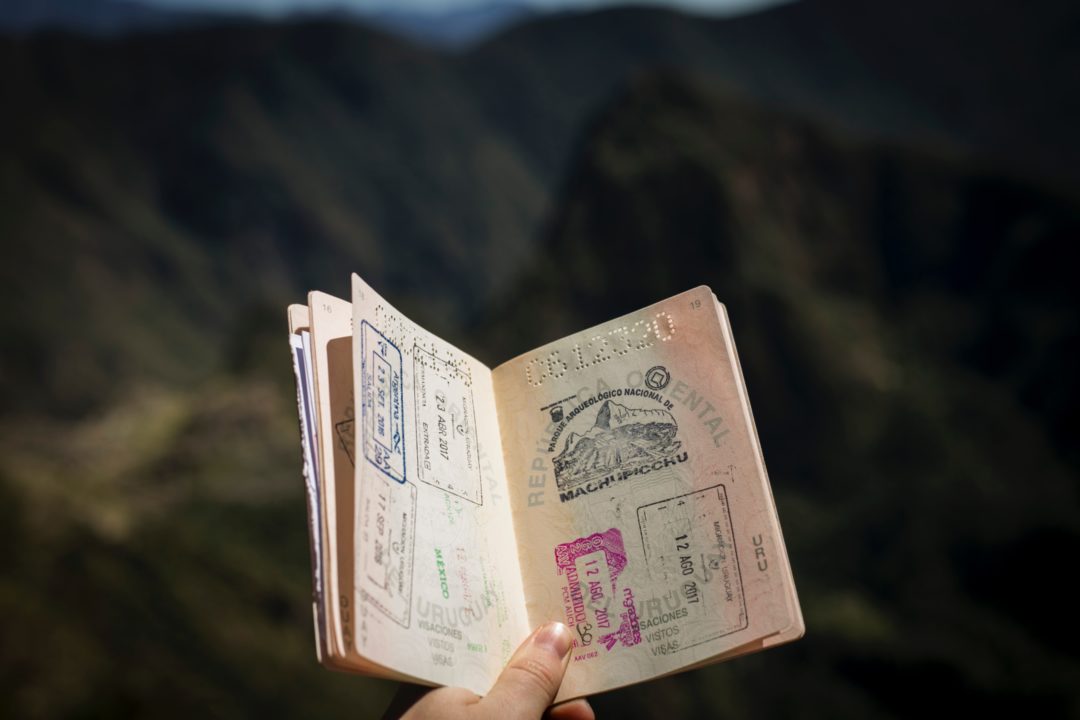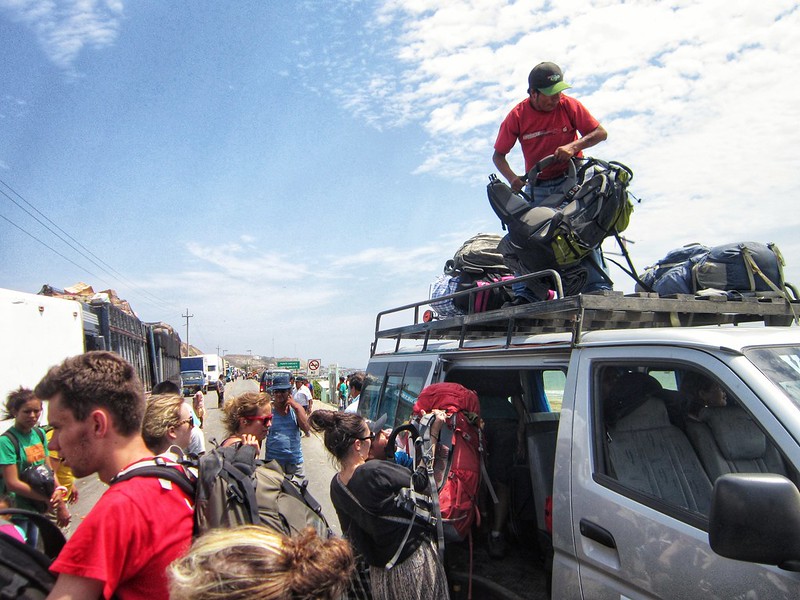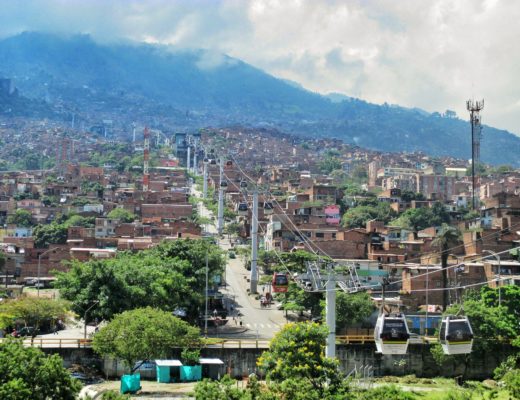The Ecuador Colombia border crossing by bus is simple.
What’s not so simple is making sure you’re on the right bus in the first place.
If you’re reading this article because you’ve googled ‘how to get across the Ecuador Colombia border’ or ‘how to get from Quito to Pasto in one day’ then congrats, you’ve come to the right place.
I spent a day travelling from Quito to Pasto (just over ten hours) and I’ve made a quick bullet-point list of the route which might well be all the information you need – but I’ve also written a story about how my journey from Quito to Pasto was much more dramatic than I thought it would be. So if you’re interested, keep reading…
- 8.45am: Taxi from Quito hostel to Quito bus station (30 mins for $10)
- 10am: Bus from Quito bus station to Tulcan bus station (5-7 hours depending on traffic for $5)
- 5pm: Taxi to Rumicacha, the Ecuador Colombia border (5 mins for $3.50)
- Border crossing inc. departure stamp in Ecuador / cross the bridge on foot / entry stamp in Colombia (time is wholly dependent on queues; cost is free for UK citizens)
- 6pm: Shared taxi from border to Ipiales bus station (5 mins for $1 / 2000 COP)
- 7pm: Taxi or minibus from Ipiales to Pasto (2 hours for $3 / 6000 COP)
- 9pm: arrive in Pasto just after dark and find pre-booked hostel
However, the best laid plans often go awry – and my journey across the border was just a little complicated. All because of a pack of Doritos.
A little backstory to Quito’s two bus terminals
Before my story starts, you should know something about the bus system in Quito, Ecuador.
Quito is a huge city which can be split into three sections: the Centro Historico in the middle, the north (Norte) district above and the south (Sur) district below. Because of both its size and location, Quito acts as a central hub for journeys all across the country. Although there used to be just one central bus station called Cumanda, nowadays there are two major inter-provincial stations: Terminal Carcelen in the north of the city and Terminal Quitumbe in the south. As you might imagine, there’s several miles and hundreds of congested streets between them.
Terminal Terrestre Carcelen is where you catch a bus to destinations in the north of Ecuador: places like Otavalo, Mindo and Tulcan. Terminal Terrestre Quitumbe takes passengers to destinations south of Quito like Cuenca, Guayaquil, Baños, Riobamba and Tena, which happen to be most of the places where travellers want to visit.
During the five months I’d been living in Ecuador, I’d passed through the Quitumbe bus station a lot. And I was probably too smug about how familiar it felt – familiar enough to stop paying attention to my surroundings.
The drama begins: which Quito bus station goes to the border?
The day dawned comfortably enough. I awoke in the top bunk of a hostel bed in Quito, packed the few things I’d withdrawn from my backpack, and headed downstairs for a quick breakfast before getting a taxi to the bus station. I’d bought the ticket for my journey to the border the night before – when I’d arrived at one of Quito’s bus stations fresh off a bus from Guayaquil – so I was adequately prepared for the day ahead.
Except somehow, in the midst of that tired arrival, I’d forgotten to check the name of the bus station I’d bought my ticket in.
As I was checking out, I asked the helpful girl at my hostel which station sent its buses to the Ecuador Colombia border. She said it was Terminal Carcelén. “That’s the one that’s at least a half hour drive from here, right?” I hastened to add. She assured me yes, and that I’d better leave pretty soon because it took almost an hour to get there.
I jumped in a cab at 8.45am and settled back in my seat, taking in my last glimpses of Ecuador’s capital. Except when my taxi driver pulled up at a bus station and demanded his $8 payment, we’d only been driving for twenty minutes. And this wasn’t the station where I’d bought my onward ticket the night before.
I was at Terminal Quitumbe in the south of Quito. And I needed to be in the north.
The realisation quickly hit that I was in the wrong place. I asked a security guard where the other bus station in Quito was.
‘Twenty five minutes away,’ he said, his finger pointing to a public bus sign which read, ‘Terminal Terrestre Carcelen’.
I didn’t think I had enough time for catching the public bus – a quick glance at my phone told me it was already 9.05am, and my bus left at 10am – so I headed back to the taxi rank I’d just left. The first driver I hailed quoted a $15 fare and said it would take an hour to make the journey to Terminal Carcelen,: ‘Es muy lejos, señorita‘, he said.
I began to crumble inside.
The drama intensifies: will I reach the right bus station in time?
The taxi slid along the asphalt of a highway clinging to the mountains surrounding Quito. I couldn’t believe quite how badly this day had begun, but I still had vain hopes that I’d reach Terminal Carcelen in time. After all, yesterday’s bus from Guayaquil to Quito had left a full thirty minutes after its scheduled departure time – surely bus delays were an Ecuadorian trait I could count on?
Luckily enough, I was right.
Racing through the rundown corridors of Terminal Carcelen, I navigated two entrance barriers and a myriad of children but managed to jump on the half-empty bus at 10.15am, just as the engine began to stir.
The faces of a dozen Ecuadorians stared flatly at me while I panted, attempting to stuff my canvas bag filled with water, bananas and a big bag of cheese Doritos into the overhead rack and then slumping down into the nearest available seat at the very front of the bus.
My stomach was starting to rumble.
The drama gets confusing: why does this bus station look so familiar?
We drove for an hour through Quito’s outskirts, picking up and dropping off passengers at seemingly random locations. I almost flew out of the open bus door as it swerved violently around countless corners, and wisely decided to retreat to a different seat.
At one point a man standing in the aisle tried to grab my bag – ostensibly to put it on the overhead rack (‘Its safer there!’ he muttered in Spanish) – but I felt almost violated, and grabbed it back towards me with the ferocity of a mother lion defending a cub. Clearly I have maternal instincts towards an iPad.
Eventually the bus began to slow down, and passengers eagerly began walking towards the door. I looked out of the window, wondering why on earth there were so many buses in this one spot. Slowly, the bus backed itself into a parking bay. What the actual hell? Why were we stopping an hour into the journey?
And then I realised.
Anyone like to guess at what station it was?

Take away the hint of a smile here and you get Flora in a stressful situation. I was about ready to dive out of the bus window…
As my heart prepared to jump clear out of my chest in frustration at seeing Terminal Quitumbe for the second time that day, the driver decided to crank up the horrific Ecuadorian music to eardrum-shattering levels. This was the point where I felt sure I’d entered some sort of twilight zone.
But wait, there’s more!
I hadn’t eaten breakfast, so I figured that while the bus was parked at Terminal Quitumbe (which I’d now begun to hate with a passion) I could retrieve my bag from the overhead rack and snack on my Doritos. But when I reached the front of the bus and grabbed it, the bag felt much lighter than it had been an hour before. I untied the double knot in the handle to find just a bottle of water and a bruised banana inside.
Drama!! Someone had STOLEN my Doritos!
Not just that – I realised that the actual situation was far more calculated.
Someone must have grabbed the bag from the rack, untied the knot, searched through the leaves contents, stolen the huge bag of crisps, and re-knotted the bag – before proceeding to throw it back in the overhead compartment. And there’d only been a handful of people on the bus!
I went back to my seat, holding my backpack fiercely to my chest (plus the rescued water and rather bruised banana) and began to worry about the safety of my main pack, buried in the bowels of the bus but actually very easy to thieve if someone fancied doing so.
Clearly this bus was filled with passengers who were happy to steal snacks; who knew what else they might try and take?
An agonisingly slow journey from Quito to Tulcan
Fifteen minutes later, the bus finally left Terminal Terrestre Quitumbe (and the site of both my anger and my embarrassment) and began its slow trundle towards the Ecuador Colombia border crossing.
Which of course didn’t take the five hours quoted at me by the woman who sold me the ticket in Quito. No. It took more like eight – by which point I was chomping at the bit with pent-up energy, frustration and hunger.
The fact that the bus was too small for the number of passengers it chose to carry didn’t help. Neither did the lack of air moving through the bus interior, or the sticky, humid heat outside that settled on every available patch of skin. I spent the entire bus ride giving myself a headache; a combination borne of barely drinking water (there was no toilet on board the bus, and the attendant seemed very against stopping) and trying to decide whether or not to risk continuing onward from the border towards Pasto.
I knew from experience that it was only a two hour journey from the border to Pasto in Colombia – but did I want to be travelling through the south of Colombia as darkness approached? It’s a situation many travellers are explicitly warned against, as the night can herald a lot more problems than the day.
Plus of course it totally depended on how long the process of crossing the border actually took.
A taxi from Tulcan to the border at Rumichaca
Our bus finally arrived at Tulcan, the nearest Ecuadorian town to the border, and an unapologetic bus boy hauled my soaking wet backpack from the confines of the bus interior.
“This part of the bus gets wet,” he said, with such nonchalance that I wanted to scream. Instead, I dug out my waterproof jacket to cope with the suddenly pouring rain, and caught a taxi to the border, trying not to imagine what else could possibly go wrong today.
I didn’t have an onward flight from Colombia. Would they try and detain me for that? Refuse to let me enter the country? Rob me at gunpoint as a side event?
A passport stamp at Ecuador Colombia border control
But against all odds, everything went fine. I got my passport stamped out of Ecuador in one office, crossed the Rumichaca bridge, and got myself stamped into Colombia within a grand total of twenty five minutes.
After all the drama of earlier, this was probably the easiest and fastest South American border I’ve ever crossed.
NB: As of 2018, there are thousands of displaced Venezuelans at the Ecuador Colombia border crossing, making the area more crowded, the queues longer, and the process more complicated. There’s no knowing how long the humanitarian crisis in Venezuela will go on for, so be sure to take that into account when planning how long your day will take.

[Image: Unicef Ecuador]
Onwards from the border to Ipiales
Once I was on the Colombian side and in another country, everything moved like clockwork. A taxi driver guided me to the back seat of his car where a group of other passengers were waiting – I was the final seat he needed to fill before driving us all to the bus station in Ipiales.
At Ipiales Bus Terminal, I paid the taxi driver, then walked down a flight of steps and straight towards an office.
“Donde vas?” a group of men chorused from behind the glass. At my response of ‘Pasto’ their reaction was nothing short of explosive. They beckoned for me to come closer to their booths; to pay them a ticket price of 6000 pesos; and to snatch a receipt from a proffered hand.
I leapt over a turnstile and into a waiting minibus, which revved its engine even as I stepped inside.
Arriving in Pasto, Colombia. Success!
I arrived in Pasto after dark, as I’d expected, with absolutely zero problems. There were no repeated visits to the same bus stations; no miscommunication with drivers or busboys or ticket sellers; and no theft from inside the bus or out of it.
Apparently Colombia’s bus system is a lot more trustworthy than Ecuador’s. Or rather, they know the difference between north and south better than all Ecuadorians and me put together.
How to cross the Ecuador – Colombia border
For those attempting the same journey as I did in one day – from Quito to Pasto – these are the facts you need to know.
- Get yourself to Quito’s ‘Terminal Quitumbe’ bus station: Ecuador’s capital is a huge city, and it costs a lot to traverse it in a taxi. Find out which bus station is closest to your Quito hostel and try to go to the border from that station (if you don’t want to double back on yourself). However, most people will tell you that the buses to the Ecuador-Colombia border crossing depart from Terminal Quitumbe.
- Catch a bus from Quito to Tulcan: From Terminal Quitumbe (in the south of Quito), buses go every hour to Tulcan, cost around $5, and take anywhere between 5 and 7 hours. The other station, for the record, is the Terminal Carcelen in the north of Quito.
- Take a taxi to the Rumichaca border crossing: When you arrive in Tulcan, get a taxi to the border itself ($3.50, 5 mins). The Ecuadorian immigration office will be on your side of the Rumichaca bridge. Once you’ve got your passport stamped, cross the Rumichaca bridge by foot and walk up a covered ramp to the Colombian immigration. When you’ve finished, walk back towards Rumichaca bridge again; there’s a small car park with taxis and shared micro buses.
- Take a taxi from the border to Ipiales: a shared taxi costs $1 or 2000 COP, and takes 5 minutes to reach Ipiales bus station.
- Catch a bus from Ipiales to Pasto: There are lots of bus companies going to Pasto: I rode in a minibus (approx. 14 seats) which took 2 hours and cost 6000 COP.
- Sleeping in Pasto: There are a handful of good hostels in Pasto – I stayed at the Koala Inn hostel but it’s sadly now closed down. However, I’ve heard good things about Casa Hospedaje la Bohemia – check it out here.
Have you ever experienced a border crossing drama like this? How about an extreme travel-crazed drama? (Although I sincerely hope you’ve never had your Doritos stolen. Some things I wouldn’t wish on anyone…)












16 Comments
romo
March 27, 2014 at 3:40 amnice post! what an adventure!
Flora
March 27, 2014 at 4:02 amCheers Romo!
Raphael Alexander Zoren
March 27, 2014 at 12:53 pmI totally love border crossing, although they have the potential to be extremely annoyed when you cross as a part of a bus. We spent about 1 hour stuck at the Turkey-Greece border because some people in the bus didn’t have the proper documentation to cross unto the EU.
Flora
April 3, 2014 at 5:10 pmMy absolutely horrific (and ultimately pointless) border crossing to Argentina from Bolivia took about four hours exclusively because there was an entire busload of teenagers on a school trip. A guy in the queue with me said that usually that crossing takes no more than a half hour..1
Brenna
March 27, 2014 at 1:06 pmI also had something stolen on a bus in Colombia… a bottle of Coca Cola! Again, it’s not the value of the object, it’s that the act took place at all. I kept asking everyone in Spanish where it was until the man gave it back to me. I felt a bit guilty afterwards – why didn’t I just let him take the bottle? – but in the end, I don’t think that anyone should steal, ever. I’m sure if he had just asked for it I probably would have said yes.
Flora
April 3, 2014 at 5:09 pmThis makes me wish I’d asked about my Doritos! You’re totally right though – stealing is wrong, regardless of the circumstances, but it’s sometimes very difficult to quantify why you should have something that the thief clearly needs a lot more..
Gary Cartzdafner
March 30, 2014 at 11:28 amI really loved the ricky racer bus drivers in Colombia. These guys put Nascar drivers to shame. From huge luxury buses to mid size to minivans, they only have one speed..pedal to the metal and fewer accidents to boot……..
Flora
April 3, 2014 at 5:08 pmVery true – although I did pass a two motorbike crash in Medellin yesterday. Eyes on the road as well as the pedal guys!
Gary Cartzdafner
March 30, 2014 at 11:45 amyou are fearless
http://youtu.be/v6G760BS6eg
Flora
April 3, 2014 at 5:06 pmCheers Gary!
Lauren
April 7, 2014 at 2:14 amI would have been super angry about the Doritos, too! Not because it was Doritos but because to have something stolen from you…you definitely feel violated! I would have been upset. I probably wouldn’t have had the guts to ask anyone for it back though. It also is terrible if you’re feeling really hungry, and that bus ride did not sound like fun!
Flora
April 15, 2014 at 10:50 pmI DID feel violated! Slightly ridiculous about the circumstances, but violated nonetheless!
Susan @ Travel Junkette
April 18, 2014 at 8:35 pmOh, man — not the Doritos! Haha. Great story, though I feel your pain. There are just THOSE days when traveling. Enjoy Colombia; it’s one of my favorite countries!
Flora
April 25, 2014 at 6:44 pmAh, THOSE days… Luckily Colombia is treating me a lot better now!
Ryan
May 25, 2014 at 3:23 pmFlora,
Sorry to hear about your misadventures while coming back to querida Colombia, although it does make a good story 😉 … I too had a very bad experience on the Ecuador / Colombia border, and was just relieved to get back. After the experience I swore I would never take an Ecuadorian bus again.
Anyways, if I ever see you in MDE, I invite you to your very own bag of Doritos. 🙂 Saludos!
Flora
June 2, 2014 at 4:43 pmHaha Doritos have a very important place in my life now! Sad we’ve missed each other in Medellin though – next time please 🙂